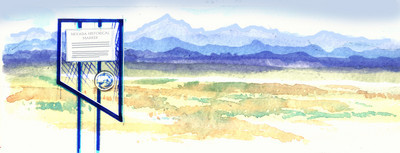State’s historical markers offer wealth of interesting tidbits
Scattered across Nevada, 253 historical markers reveal snippets of the Silver State's fascinating past. Supported by sturdy blue-painted frames and metal mesh, the text appears in blue incised upon a silvery metal plate, representing Nevada's official colors. Each marker describes events, travel routes, locations or people figuring prominently in Nevada's history.
History buffs delight in perusing the markers and a few travelers read them while breaking their long drives, but most motorists pass them by without a glance. That is really a shame, for the markers offer a wealth of information about the state's history on or near the sites where events unfolded that shaped Nevada as it is today.
You could travel our huge state's highways many times and not spot all the markers. However, the Nevada Historic Preservation Office offers a couple of ways to access the information, even if you are only an armchair traveler. Those with internet access may visit the State Historic Preservations Office's Web site for a printable index by county and complete texts of the markers. If that seems too laborious or your printer is low on ink, simply call Marie Lowe at the preservation office's Historic Marker Program in Carson City at (775) 684-3448. She will mail you a free, updated copy of "Nevada Historical Market Guidebook," a softbound publication containing all the marker texts, maps, photos and illustrations. This guide should also be stocked in the bookshops of state museums across Nevada, available without charge.
Nevada's Historical Marker Program started in 1967 when the state legislature initiated the effort to focus public attention upon Nevada's long and interesting past. The program involves the cooperation of several state agencies including the administering State Historic Preservation Office which is part of the Department of Museums, Library and Arts; the Northern Nevada Correctional Center where the markers are constructed; the State Historical Society which reviews texts; and the Nevada Department of Transportation, charged with installation and maintenance of the markers. Funding for the free guidebook comes out of taxpayers' money allotted to the NDOT budget, just like the widely distributed official Nevada State Highway map, another free boon for travelers.
Clark County alone accounts for about 30 markers. A couple trace history back into an age of now extinct creatures. Some sketch a little of cultures predating ours by thousands of years. Several mark the importance of early overland routes like the Old Spanish Tail. Others tell brief stories of explorers, pioneers, ranchers, railroaders and miners.
Read those markers to find out how one-armed frontier surveyor John Wesley Powell ended up near Echo Bay in 1869 or how a soldier named Beale brought camels to the Nevada desert near present-day Laughlin in 1857. You don't even have to travel out of Las Vegas to find out about one of Nevada's first settlements and its oldest building. After reading the maker at the corner of Las Vegas Boulevard and Washington, visit the site yourself at the Old Mormon fort, a Nevada state historical park.
In some places where markers stand across the state, visitors can still pick out the routes followed by emigrants, Pony Express riders, stagecoaches, Mexican traders or rustlers returning from raids on California ranchos. Actually being on-site impresses you with the toughness and fortitude of those early travelers.
Except for the width of the highway near which you stand, much of Nevada has changed very little since those days. It is still a rugged landscape.
So many colorful characters found their way to Nevada. The markers tell about folks like newspapermen and humorist Mark Twain in Virginia City and John C. Fremont, soldier and explorer who visited both northern and southern Nevada, leaving place names like Pyramid Lake and mapping routes for emigrants.
Of course, the state had its share of rascals like "Diamondfield Jack" Davis, a gunman enforcing cattlemen's rules on sheepherders near the Idaho line for ranchers like future Governor John Sparks -- the stuff of Western movies, but true.
Margo Bartlett Pesek's column appears on Sundays.
MARGO BARTLETT PESEKMORE COLUMNS






















